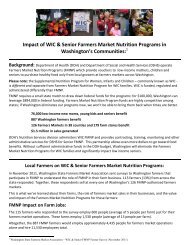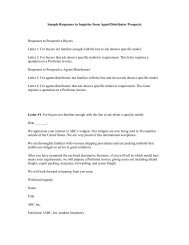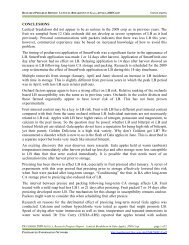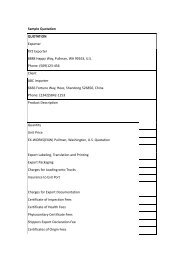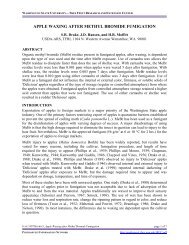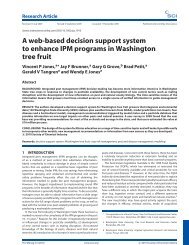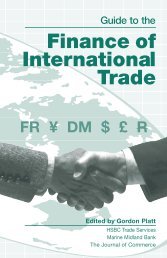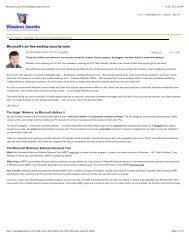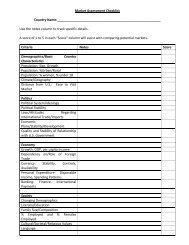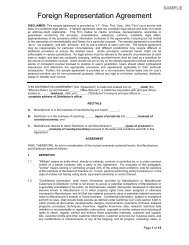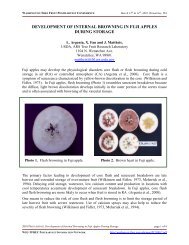Fresh Fruit Packing General Permit Renewal - Postharvest ...
Fresh Fruit Packing General Permit Renewal - Postharvest ...
Fresh Fruit Packing General Permit Renewal - Postharvest ...
You also want an ePaper? Increase the reach of your titles
YUMPU automatically turns print PDFs into web optimized ePapers that Google loves.
WASHINGTON TREE FRUIT POSTHARVEST CONFERENCEMarch 12 th & 13 th , 2002, Yakima, WAFRESH FRUIT PACKING GENERAL PERMIT RENEWALTHE FRUIT INDUSTRY & WSDOE WORKING TOGETHERSTEVE HUBERSteve Huber, Department of Ecologyshub461@ecy.wa.govBrent Milne, McDougall & SonsBMILNE@mcdougallfruit.comIntroductionBrent and I had an interesting time collaborating on this presentation. I think he will agree thatworking together gave both of us an opportunity to see the issues from different perspectives.Hopefully, we can pass on some of what we learned to you.We have four topics we would like to cover today. I will start out discussing permit compliancetrends and the permit renewal process. Brent will then give a summary of where we are in theprocess and how we got here, including the formation of the tech team. Finally, we will bothreview the goals and accomplishments so far.2001 Yearly Facility ReportI would like to start by saying I saw a major improvement this year in Yearly Facility Reportsubmittals. 85% were in on time and only 27 late notices were sent out. At this point all thereports are accounted for. I would like to thank all those who got the YFR in on time, andespecially those who sent it in early. This really helps evens out the data entry workloadCompliance RateAnother positive note is theoverall compliance rate forthe industry. This chartshows the number of teststhat were in compliance eachyear. As you can see therewas dramatic improvement inthe first few years aswastewater issues wereaddressed and everyonebecame more familiar withthe permit requirements. Therate has settled in around95% for the last few years.This is an excellent numberand you should be proud ofyour achievements inwastewater management.% TESTS IN CO M PLIAN CE9896949290COMPLIANCE RATE% OF TESTS IN COMPLIANCE9496978887861995 1996 1997 1998 1999 2000 20019596952002 PROCEEDINGS, <strong>Fresh</strong> <strong>Fruit</strong> <strong>Packing</strong> <strong>General</strong> <strong>Permit</strong> <strong>Renewal</strong> page 1 of 7WSU—TFREC POSTHARVEST INFORMATION NETWORKhttp://postharvest.tfrec.wsu.edu/PC2002C.pdf
WASHINGTON TREE FRUIT POSTHARVEST CONFERENCEMarch 12 th & 13 th , 2002, Yakima, WACompliance TrendsHowever, we don’t want to forgetabout that last 5%. Because inmost cases samples are taken just COMPLIANCE TRENDSonce a quarter each test ispotentially significant and may be3000an indicator of an issue that needs2500REPORTINGto be addressed. This chart takes acloser look at that 5% noncompliance.I have separated the15002000EFFLUENT2187violations into two types: effluent10001120violations (yellow) which are test437 441761results which exceed the permit500454 431616limits and non-reporting violations425 402 428 344 317 3220(blue) which are missed tests or1995 1996 1997 1998 1999 2000 2001blank boxes on the reports. Onceagain we see the big gains in thefirst 3 years, particularly in thenon-reporting violations. Then it flattens out at around 700 to 800 violations per year. The blipin 1999 was probably due to the new permit issued in July 1999. One interesting trend I noticedwas that while 50% the facilities (100) had no violations, just 20% of the facilities (40)accounted for 80% of the violations.NUMBER OF VIOLATIONSEffluent Limit Violations Compliance OpportunitiesThis figure shows a breakdown of the effluent limit violations between those that the facility hasdirect control over such as pH and total residual chlorine, and others that are best dealt with on acase-by-case basis. By using pH adjustment and dechlorination as needed, effluent limitviolations could be reduced by 28%.EFFLUENT LIMITCOMPLIANCE OPPORTUNITIES28%OTHERPROCESSCONTROLPHTRC2002 PROCEEDINGS, <strong>Fresh</strong> <strong>Fruit</strong> <strong>Packing</strong> <strong>General</strong> <strong>Permit</strong> <strong>Renewal</strong> page 2 of 7WSU—TFREC POSTHARVEST INFORMATION NETWORKhttp://postharvest.tfrec.wsu.edu/PC2002C.pdf
WASHINGTON TREE FRUIT POSTHARVEST CONFERENCEMarch 12 th & 13 th , 2002, Yakima, WANon-Reporting Violations Compliance OpportunitiesThe same holds true for the non-reporting violations. Making sure all the samples are collectedand the reports are filled out completely would eliminate all of these violations. Even if a sampleis missed those parameters that are monitored by the facility such as pH, TRC, flow, andtemperature can still be reported. Some ideas for reducing the number of missed samplesinclude: 1) having a reminder system, 2) taking samples early in the quarter and 3) training abackup in case the regular person responsible for monitoring is out.NON-REPORTINGCOMPLIANCE OPPORTUNITIES57%PHTESTEDBY LABTESTED BYFACILITYTRCFLOWTEMPCALCCompliance SummarySo to wrap it up, by doing those three things which you have direct control over: 1) getting allsamples, 2) filling in all blanks on the reports and 3) doing pH adjustment and dechlorination asneeded, non-compliance would be decreased by almost 70%.One thing I am planning to do to help you with your ongoing efforts to improve compliance is tosend each facility a summary of the violations they had each year. The purpose of this report isto provide you with a tool to help you identify trends or areas of concern.<strong>Permit</strong> <strong>Renewal</strong> TimingI would now like to move on to the permit renewal process. This is a five-year cycle as specifiedin the regulations. The general permit was issued in March 1994 and renewed on July 1, 1999.Therefore it is due for renewal on July 1, 2004, which put us half way through the cycle. Whilethat sounds like there is a lot of time left, given the required procedures it really isn’t.Informal <strong>Renewal</strong> Process—Years 1 to 4I have broken the renewal process into two parts. The first four years is a more informal processwith industry and Ecology working together to identify and resolve any permit issues. This timeis used to gather any information and data needed to make good decisions. The goal is to have2002 PROCEEDINGS, <strong>Fresh</strong> <strong>Fruit</strong> <strong>Packing</strong> <strong>General</strong> <strong>Permit</strong> <strong>Renewal</strong> page 3 of 7WSU—TFREC POSTHARVEST INFORMATION NETWORKhttp://postharvest.tfrec.wsu.edu/PC2002C.pdf
WASHINGTON TREE FRUIT POSTHARVEST CONFERENCEMarch 12 th & 13 th , 2002, Yakima, WAthe final draft permit complete by July 1, 2003. You can see this leaves us only 1-½ years or onepacking season to gather information and develop the draft permit.Formal <strong>Renewal</strong> Process—Year 5The final year is the more formal process required by the regulations. A public notice of draftmust be published in newspapers, the state register, and mailed to all permittees and interestedparties. Workshops will be held if needed and at least one public hearing is required. At the endof the comment period a response to comments is prepared and the final permit is written. Ifthere are significant changes the process goes back to step one and another public notice of draftis done. If there are no significant changes a public notice of issuance is done similar to thenotice of draft. The permit will then be issued 30 days later, followed by a 30-day appeal period.One additional step is the submission of an application for renewal of coverage by all permittees.This must be received by January 1, 2004 (180 days before the old permit expires). Theapplication form will be sent to you several months before it is due to give you time to prepare it.Don’t worry about remembering all this. You will receive several mailings to keep you informedof where we are in the process and what actions you need to take.BRENT MILNETales From Down the PipeIn the spring of 2001 the Pacific Northwest and indeed most of the U.S. was beset by an energycrunch. The net result of which, among other things, was the potential loss of lignosite, one ofthe three pear floats available to pear packers, and widely used in the Wenatchee District. Itshould be noted at this point that the perceived lack of lignosite was the catalyst that brought theWSDOE and <strong>Fruit</strong> Industry together for the discussions that will ultimately span the entirebreadth of the <strong>Fresh</strong> <strong>Fruit</strong> <strong>Packing</strong> <strong>General</strong> <strong>Permit</strong>.The net result of the potential lack of lignosite was a scramble during the late spring and summerof 2001 by pear packers using lignosite as their primary float material to find an alternative pearfloat. The list of approved float products is very short and those that are available are fraughtwith a host of practical use issues that make a switch for a packer difficult at best.Along with the practical issues surrounding the selection of a pear float material to use in placeof lignosite, pear packers were also faced with regulatory issues as spelled out in the <strong>Fresh</strong> <strong>Fruit</strong><strong>Packing</strong> <strong>General</strong> <strong>Permit</strong>. The WSDOE was concerned that packers might delve into floatingpears with alternative materials that had not been entirely proven. Ultimately, the fruit industryand the WSDOE recognized the need for candid, timely discussion of these issues…more aboutthat later.Products are ‘Floated’Throughout the summer of 2001 pear packers (particularly those in the Wenatchee District),spent a great deal of time analyzing their particular pear float/TDM situation. Those that weresending rinse water to POTW’s were particularly interested in ‘new’ materials such as potassiumphosphate and potassium carbonate as float materials. A rehash of the appropriate use of sodiumsilicate and sodium sulfate was also underway. A quick review of the three permitted pear floatand their inherent difficulties follows:1. Lignosite—BOD, TDS, color, lack of production due to energy crunch, spring of 2001.2002 PROCEEDINGS, <strong>Fresh</strong> <strong>Fruit</strong> <strong>Packing</strong> <strong>General</strong> <strong>Permit</strong> <strong>Renewal</strong> page 4 of 7WSU—TFREC POSTHARVEST INFORMATION NETWORKhttp://postharvest.tfrec.wsu.edu/PC2002C.pdf
WASHINGTON TREE FRUIT POSTHARVEST CONFERENCEMarch 12 th & 13 th , 2002, Yakima, WA2. Sodium Silicate—pH, abrasiveness, toxicity, settleability. The material is used, but notallowed to POTW’s.3. Sodium Sulfate—TSS, Sulfate Effluent Limits, settleability, and difficult to charge a tankand keep in solution, as well as corrosiveness and other difficulties connected with itsuse.4. Floatless dump systems—Available, but not widely employed for reasons beyond thescope of this presentation.One of the greatest obstacles encountered in the use of either the ‘new’ or ‘old’ pear floats (asidefrom the lack of permit status) was the issue of ‘settleability’ at the receiving POTW’s. Clearly,much work needed to be done to answer the question of settleability as well as a host of otherissues connected with the use of any of the pear floats, ‘new’ or ‘old’, that were going to maketheir way eventually to a POTW or any other TDM.<strong>Fruit</strong> Industry and WSDOE ‘Plunge’ AheadThis entire chain of events throughout the spring and summer of 2001 brought a group of pearpackers and other interested industry people together in re-establishing the wastewater subcommitteeof the <strong>Postharvest</strong> committee of WSHA. The group has taken to calling itself theWastewater Technical Team or ‘Tech Team’. This sub-committee had been very active in thepast where the <strong>Fresh</strong> <strong>Fruit</strong> <strong>Packing</strong> <strong>General</strong> <strong>Permit</strong> was concerned, so mention of the good workdone by the original group of people, both industry and regulatory, involved on the committee inthe past is warranted.The focus of the latest rendition of the Tech Team can be summarized in terms of ‘immediate’goals and long-term goals. The immediate goals of the Tech Team are to:1. Have candid and constructive discussions between the fruit industry and WSDOEregarding the issues and topics of concern before the group.2. Clarify the product testing procedure as spelled out in the <strong>General</strong> <strong>Permit</strong> itself and otherpertinent WAC’s.3. Review current and future treatment disposal methods (TDM’s) and best managementpractices (BMP’s) with the goal of preserving as wide an array of options to packers aspossible.<strong>Fruit</strong> Industry & WSDOE ‘Plunge’, Long-Term GoalsThe long-term goals are to:1. Develop an understanding of and be active in the long-term nature of the <strong>General</strong><strong>Permit</strong>. In other words, seek to keep the wastewater technical sub-committeefunctioning during the ‘off’ years between permit cycles.2. Meet at a minimum of twice per year, more often as necessary.3. Actively evaluate new products.4. Seek to truly make the <strong>General</strong> <strong>Permit</strong> a ‘living’ document. In other words, adocument that is constantly held up to scrutiny and changed as processes change ornew information becomes available.2002 PROCEEDINGS, <strong>Fresh</strong> <strong>Fruit</strong> <strong>Packing</strong> <strong>General</strong> <strong>Permit</strong> <strong>Renewal</strong> page 5 of 7WSU—TFREC POSTHARVEST INFORMATION NETWORKhttp://postharvest.tfrec.wsu.edu/PC2002C.pdf
WASHINGTON TREE FRUIT POSTHARVEST CONFERENCEMarch 12 th & 13 th , 2002, Yakima, WA5. Developing a collaborative and functional DOE/Industry structure within theframework of the <strong>General</strong> <strong>Permit</strong> that responds to issues in a timely fashion therebyavoiding elevating a particular issue to ‘knee-jerk’ or ‘emergency’ status.The Tech Team: ‘Fellowship of the Drain’The ‘Tech Team’ members represent many facets of the fruit industry in Washington State,thereby giving the ‘industry’ the representation needed in close collaboration with the WSDOE.THE TECH TEAM“FELLOWSHIP OF THE DRAIN”PACKERS “NORTH”! DALE DAVIS – MAGI! JEFF KRAUSE – BLUE BIRD! ERIC STRUTZEL – BLUE STAR! BRENT MILNE – McDOUGALLPACKERS “CENTRAL”! ROB CONRAD – KERSHAW! KEITH LARSON – LARSON FRUIT! BRAD TUKEY - SNOKISTPACKERS “SOUTH”! DON GIBSON – UNDERWOODTRAFFIC ASSOCIATIONS! MILES KOHL – YVGS! CHARLIE POMIANEK - WVTALABORATORIES! LAURA MRACHEK – CASCADE ANALYTICALDISTRIBUTORS! KEN BOSSEN – WILBUR ELLIS! MATT LORZ – NORTHWEST WHOLESALE! MAURY SMITH – STERI-SEALRESEARCH! GENE KUPFERMAN – WSU! SHAWN McNEIL – WTFRC! PETER SANDERSON – WTFRCWSDOE! STEVE HUBER – WSDOEPOTWS• AS NEEDEDPRODUCT MANUFACTURERS• AS NEEDEDResults to Date: “Good Plumbing Avoids Clogs”The ‘Tech Team’ has met twice over the past eight weeks. Both meetings have produced apalpable sense of progress as well as the following results:1. The process by which both modification of the permit and new product approval isachieved is more clearly understood. This will lead to routine, active evaluation ofproducts as the new products become available.2. The latest meeting of the group revolved around the candid discussion of thepermitted pear floats, their TDM’s and BMP’s. The goal here is to retain those floatsthat are permitted, and in fact add new materials to the list.2002 PROCEEDINGS, <strong>Fresh</strong> <strong>Fruit</strong> <strong>Packing</strong> <strong>General</strong> <strong>Permit</strong> <strong>Renewal</strong> page 6 of 7WSU—TFREC POSTHARVEST INFORMATION NETWORKhttp://postharvest.tfrec.wsu.edu/PC2002C.pdf
WASHINGTON TREE FRUIT POSTHARVEST CONFERENCEMarch 12 th & 13 th , 2002, Yakima, WA3. Agreement has been reached to meet no less than bi-annually, and more often asrequired.4. A survey of the industry is underway to more clearly understand current usagepatterns and identify the needs of the industry with regard to wastewater managementat this point in time. Peter Sanderson with the Washington Tree <strong>Fruit</strong> ResearchCommission, Miles Kohl with the Yakima Valley Growers/Shippers and CharliePomianek with the Wenatchee Valley Traffic Association are spearheading thesurvey.5. Calls to potential ‘new’ pear float manufacturers to begin testing.STEVE HUBERIssuesThe first thing I should say is that Ecology is not planning a major rewrite of the permit.The basic TDM structure, effluent limits, and best management practices will stay the same.However, several issues have been identified so far. The first is pear float materials, which Brenthas already talked about. The second issue is unlined percolation ponds. According to myrecords there are a total of about 60 unlined percolation ponds in use. Of those 40 receive noncontactcooling water only. At this point these are not an issue. However, there is a concern thatthe 20 ponds receiving packing process wastewater may not be providing adequate treatment.We need to begin the process of verifying what is currently being used and determining if theyare providing adequate treatment. Every effort will be made to keep the percolation TDM.However, the requirements for what constitutes an acceptable system may need to be changed.If any changes are found to be necessary, they would not be implemented before the new permitis issued in July 2004. However, if you are using one of these unlined percolation ponds Iwould encourage you to minimize your risk by doing whatever you can to reduce the amount ofBOD and other pollutants discharged to the pond. This could include considering alternativeTDMs. Be sure to call me if you have questionsSummaryIn summary, the industry should be congratulated for its overall excellent compliance numbers.Continue to look for opportunities to improve compliance, especially those parameters you havedirect control over like pH, TRC, temperature, and flow. We are about half way through thefive-year permit cycle, so renewal is coming up fast. The tech team has been formed to facilitatethe ongoing process of dealing with issues in a timely manner. Be sure to communicate withthem and Ecology with any questions or concerns. Also, watch for mailings to keep youinformed.2002 PROCEEDINGS, <strong>Fresh</strong> <strong>Fruit</strong> <strong>Packing</strong> <strong>General</strong> <strong>Permit</strong> <strong>Renewal</strong> page 7 of 7WSU—TFREC POSTHARVEST INFORMATION NETWORKhttp://postharvest.tfrec.wsu.edu/PC2002C.pdf




